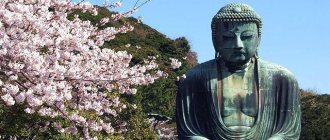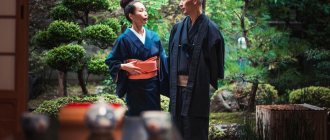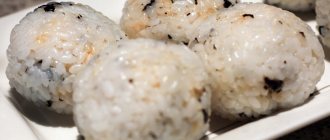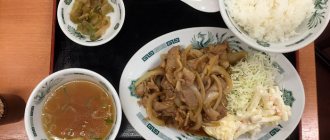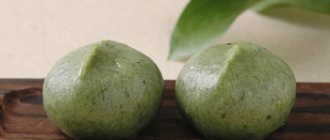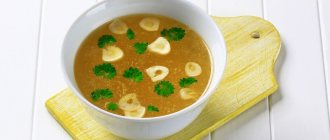Sake (Japanese sake) is the national alcoholic drink of the land of the rising sun. This bright, refined rice drink with a strength of 13 to 18 degrees is known as “Japanese liquor.” It is brewed like beer rather than distilled like vodka and is usually served hot. Sake goes well with Japanese cuisine. There is an opinion that the strength of the drink reaches 30-45 degrees, but the Japanese have a special name for this alcohol - shochu. The drink is usually served during formal ceremonies, special events and holidays. Sake is served in a tall ceramic container of various shapes, with a volume of 360 milliliters, called tokkuri. It is immersed in a vessel of hot water to heat the drink before pouring, and the narrow neck prevents it from cooling. Pour the drink into small porcelain cups.
History of the drink
It has been made for more than 2000 years, and once upon a time the sake recipe was borrowed by the Japanese from the Chinese. The idea was taken as a basis for rice beer, which the Chinese brewed back in BC.
When sake first appeared, its price was quite high, it was quite rare, which is why it was drunk mainly by rich people, temple servants and persons of imperial blood. In the Middle Ages, sake gained wide popularity in Japan, and began to be considered the most affordable drink in Japan, which even the poor drank.
Chronicles from the 8th century BC indicated that the Japanese worshiped the deity of rice wine, and according to legend, sake was invented as a sacrifice in order to appease the gods, who were supposed to give a good harvest.
The Japanese even celebrate Sake Day, which occurs on October 1st. This is a very ancient holiday, it was timed to coincide with the beginning of the new wine production season, because it is in early October that rice ripens.
History of sake
The Japanese began producing sake soon after mastering wet rice cultivation in the 3rd century BC. The oldest written records of Japanese sake are found in history books of the third century. According to records, the Japanese consumed the drink while mourning the dead. By the seventh century, there were standardized production methods used at the imperial palace at Nara on the island of Honshu. In the tenth century, natural fermenting agents were used. The eighth-century book Fudoki, which describes the characteristics of the Japanese provinces, contains descriptions of the foods consumed at that time. Among other things, there is mention of sake made using mold, rice and koji. The tenth-century ritual code Engisiki contains details of ancient methods for making the drink. At that time, sake was produced primarily at the imperial court, either for the emperor's consumption or for ceremonial purposes. In ancient Japan, sake production was limited to the imperial palace and major temples, which explains the drink's association with religious rituals and celebrations. Today, sake is served during traditional ceremonies such as wedding celebrations and New Year's blessings.
Production process
Since that time, manufacturing technology has undergone significant changes, especially with regard to the fermentation process of rice.
Once upon a time, in order for rice to begin to ferment, they used the simplest method: people simply chewed it, then spat it into a container and left it to ferment that way. Currently, sake is made as follows: water, a special type of mold and yeast are added to rice. To produce the drink, special varieties of rice are now used, which contain a high concentration of starch and are large in size. There are even certain varieties of rice that are grown exclusively in order to then produce this alcoholic drink from them. Typically, these varieties are grown in the hills between the mountains, as there is a large difference in temperature between day and night, which is considered very important for the proper ripening of rice. In total, there are about 30 varieties of rice from which sake is made, and among them the most common is Yamada Nishiki. Also, all types of sake are divided into filtered and unfiltered, live and pasteurized. Mineral composition of sake
| Macronutrients | |
| Potassium | 25 mg |
| Calcium | 5 mg |
| Magnesium | 6 mg |
| Sodium | 2 mg |
| Phosphorus | 6 mg |
| Microelements | |
| Iron | 0.1 mg |
| Copper | 0.01 mg |
| Selenium | 1.4 mcg |
| Zinc | 0.02 mg |
In the production process of this alcoholic drink, special attention is paid to the selection of good purified water. It is first thoroughly cleaned and then enriched with minerals and phosphorus to create an ideal environment for the rapid proliferation of yeast and fungi. It is very important that the drink contains neither iron nor manganese so that it retains maximum purity.
The use of special molds is necessary because rice does not contain sugar, and it is vital for the rapid development of yeast. Molds that are added to water live in the water for some time and in the process transfer the sugar that is so necessary for fermentation to the rice.
Now a special type of yeast is used to stimulate fermentation, which is considered ideal for this drink. There are about a thousand varieties of such yeast created specifically for sake, and all of them were obtained under artificial conditions by scientists who were involved in the development of this amazing drink.
Stages of drink manufacturing technology
Rice grinding
The rice grains are carefully polished to ensure that unpeeled rice does not spoil the quality of sake. They are cleaned from the shell and the germ, this is done using specially designed grinding machines in which the grains undergo friction for long hours. After this, the rice, which has lost a lot of moisture, must regain it, which takes several weeks.
Washing the grains
The rice is washed with clean water using slight pressure, thereby removing all substances unnecessary for sake. In addition to cleaning, the grains are also additionally ground during the process: in this way, the highest grinding quality is achieved. After this, the grains are soaked in clean water for about a day.
Steaming
The rice grains are then steamed to soften them and also to sterilize them.
After this comes the fermentation stage of rice. Special moldy mushrooms are added to thoroughly steamed rice, which gradually break down starch and produce sugar necessary for yeast. This requires a low temperature, about 30 degrees Celsius, and a very high level of humidity, ideally 98%. This process requires two days, during which the rice grains are sometimes kneaded so that each grain is sufficiently saturated with oxygen and the temperature is maintained at the desired level, despite active fermentation.
Leaven
In order for the yeast to act most actively, it is diluted in a certain amount of water and left there for several days.
Fermentation
The resulting yeast along with water is added to the rice, and the magical process of turning the rice into an alcoholic drink begins. For the best fermentation quality, rice is added to the yeast little by little, in small portions over several days. Then the fermentation process itself begins, which, depending on the type of alcohol required, lasts from 2 weeks to a month.
Filtration
At this stage, special filters are used, as a result of which the sake is cleaned of solid parts. Afterwards, the drink is infused for a little more than a week so that all the solids settle, as well as the starch that has not fermented. The drink is then drained, leaving all solid particles at the bottom, and again carefully filtered using activated carbon.
Pasteurization
In order for all unnecessary enzymes to leave the drink, it is gradually heated to about 60 degrees.
Aging and bottling
In order for sake to acquire its full taste and aroma, it is placed in special enamel containers, where it will remain for 6 months at a temperature of strictly 20 degrees. During this aging process, the rice smell comes out of the drink, it becomes soft and pleasant to the taste. The finished drink has a strength of about 20 revolutions; it is diluted with water to about 15 revolutions and bottled.
How is sake made?
- The rice is polished to remove substances that negatively affect the taste and color of sake. The degree of “elitism” of sake depends on the degree of polishing. The smaller the remainder, the higher the premium quality of the finished drink.
- The raw materials are washed and soaked, then steamed.
- After this, the rice is artificially infected with spores of the Kojikin fungus.
- Then a yeast starter is made from the raw materials for two weeks, adding steamed rice.
- After this, the raw material undergoes fermentation in three stages: koji (rice already affected by the Kojikin fungus), Shubo yeast starter, steamed rice and water are added to the vat three times. Fermentation lasts 20 days.
- Then there are the stages of extraction, filtration and first pasteurization.
- Almost finished sake is aged for six months, after which a second pasteurization is carried out and the drink is bottled.
Filtration gives the sake almost complete clarity and only a slight pale yellow tint. Thanks to the colored dishes it is not visible in the photo
Types of sake
Japan produces a colossal amount of sake; throughout the country there are about 2,000 different enterprises that create this drink. Even in a small Japanese town, many types are produced, and the most popular in Japan is the refined type, which is most similar in taste to sherry.
Sake is divided into different types according to its taste, the presence of sweetness or spiciness, and the number of revolutions of alcohol. In particular, in Japan they produce a drink so strong that it burns the mouth. The young drink is usually lemon-colored, while the aged drink takes on an amber color. As for the bright fruity taste and aroma, it is completely unclear why sake acquires them, because neither spices nor fruits are used in its production.
Sake is divided into several types, which are used in completely different ways. Approximately 75% of the total drink produced is so-called table wine. Before drinking sake, it is best to warm it up. Premium varieties account for approximately 25% of the sake that is imported into other countries. This is an elite wine that is cooled to about 5 degrees before drinking. Both the first and second types of sake are usually served with light snacks, preferably cheese or seafood. Sake can be stored for about a year, but it is very important to keep it at a temperature no higher than 20 degrees Celsius.
There are 4 main types of sake
Junmai is pure rice sake. Nothing is used in its production except rice, water, yeast and koji. In Junmai sake, the rice should be 70% polished.
Honjojo is a little softer than jummai. A small amount of alcohol is added to it to soften the taste and highlight all the aromas of the rice used. It usually has a slightly coarse but mild flavor. Rice polishing is also 70%.
Ginjo has the same ingredients as Honjojo, but it has faster grain grinding rates, the use of a special type of yeast "ginjo yeast", longer fermentation periods and many other labor-intensive preparation processes. The degree of rice polishing is 60%.
Daiginjo - This has an even more painstaking preparation process than ginjo, resulting in sake that is even lighter, more flavorful and fruitier than a typical ginjo. You must use rice that is at least 50% polished (the best sake is 35% polished rice)
- Daiginjo = super premium
- Ginjo = premium
How to drink sake correctly?
In Japanese restaurants, cheap table sake is served warmed up. And this is 75% of production volume. It can be drunk both cold and hot; it does not have a particularly subtle taste, but a warmed drink hides the shortcomings of low-quality sake.
Good sake is drunk cold or at room temperature.
It is interesting that it is customary to drink hot sake in one gulp, and it is pleasant to sip good cold sake, enjoying the delicate taste. The main thing, don’t forget to drink to the bottom!
October 1 is sake day in Japan.
Beneficial features
If sake is consumed in moderation, it has an extremely positive effect on the body. Research conducted by Japanese scientists led them to the conclusion that sake can significantly improve memory, normalize blood pressure, and also stimulate blood circulation. It is also recommended to use it to improve heart function, thereby preventing heart attacks or angina. Sake inhibits the formation of malignant tumors, so it serves as a good prevention of oncology. The Japanese sincerely believe that sake can prolong youth, especially since it is valued as a sacred drink.
The substances contained in sake have the ability to disinfect. In particular, compresses with this drink are used to help hemorrhages resolve faster. It is believed that sake can also help in cases of chronic fatigue, which, among other things, leads to insomnia. To combat such problems, you need to take a bath, adding 200 ml of sake to it. It is especially useful to do this before bed; such a bath helps you relax, calm down and fall asleep.
Benefits of sake
The drink contains amino acids, which are 7 times more than in red wine. These acids have a positive effect on the immune system, strengthen it and prevent the development of malignant tumors.
Sake in moderation has a positive effect on the body. Research by Japanese scientists has shown that those who drink sake stabilize their blood pressure and improve their memory. When drinking the drink, good cholesterol increases in the blood and blood circulation is stimulated. Sake has a preventive effect on the heart, preventing angina and the possibility of a heart attack. The drink also has disinfecting and antiseptic properties. If you apply a sake compress to a scratch, contusion or bruise, the subcutaneous hemorrhage will resolve much faster.
Sake has a positive effect on the skin. Using the drink as a wiping lotion, you can quickly get rid of acne, cleanse your skin and tighten pores. After application, the skin becomes soft, tightened, and a healthy color appears. For hair, you can use a rinse based on sake (50 g), vinegar (30 g) and water (200 g). This solution makes hair shiny, silky and manageable.
Those who suffer from insomnia or chronic fatigue should take a bath with sake (200 g) before going to bed. This will relax the muscles, calm the nervous system and warm the body.
In cooking, sake is used to remove unpleasant odors from a dish. In the bar business it is used to make cocktails.
Harm of sake and contraindications
The alcohol contained in sake, with prolonged and excessive consumption, negatively affects liver cells and, as a result, can lead to the development of cirrhosis.
It is not recommended to drink the drink for pregnant women, nursing mothers, people taking medications that are incompatible with alcohol, as well as for children under 18 years of age.
Tatyana Eliseeva chief editor of the Food+ project
Ask a Question
Rating:
0
/10
Votes: 0
Material usefulness 0
Reliability of information 0
Article design 0
Use in cosmetology
Sake has a very good effect on the condition of the skin; Japanese women even use it instead of lotion, rubbing their skin with it. Thanks to this, the skin is cleansed, pores are narrowed, and the tonic saves from acne. If you regularly use sake, the skin tightens, becomes much softer, and its color improves.
The Japanese also use this drink for their hair: to rinse it, take 50 ml of sake, add 200 ml of water and 30 ml of vinegar, which makes the hair softer, more manageable and healthy.
How to drink correctly
Best materials of the month
- Coronaviruses: SARS-CoV-2 (COVID-19)
- Antibiotics for the prevention and treatment of COVID-19: how effective are they?
- The most common "office" diseases
- Does vodka kill coronavirus?
- How to stay alive on our roads?
How you drink sake depends entirely on your preferences. In general, it is best to use a drink at a temperature of 15 to 30 degrees Celsius; stronger varieties are recommended to be heated before drinking, and less strong ones, on the contrary, to be cooled.
Sake can be made at home, but it requires special ingredients and a fairly long preparation process, as well as very careful filtration, to get a perfectly tasty drink.
Consumer culture
By the end of the 20th and beginning of the 21st century, sake became popular abroad, but lost its position in Japan. Abroad, sake is currently used in its pure form, in cooking and for the production of fashionable cocktails.
Sake is traditionally drunk from a porcelain cup. Sometimes, the pre-moistened rim of the cup is dipped in salt, after which the drink is poured into the container. Fifteen degrees Celsius is the recommended drinking temperature for most types of sake. Once the bottle has been opened, the drink must be consumed without delay, before oxygen acts as an oxidizing agent and spoils the taste. Avoid buying sake that has been kept warm. Cheap varieties have an unpleasant odor and strong taste. As a rule, they are made using non-standard production technologies and have many additives. A good drink is made from high-quality water and selected rice.
The ideal drinking temperature depends on the brand and type of sake. More expensive varieties are usually served chilled. Aesthetes consume the drink, heated before serving from 17 to 20 degrees Celsius.
In autumn and winter, it is time to consume a drink designed to heat up to 38 degrees. The heated drink provides physical and psychological warmth in winter and is traditionally served with hot pot dishes. You need to be extremely careful, as sake is sometimes served warm to hide any imperfections.
Contraindications and harm
Be that as it may, sake is an alcoholic drink, and its regular consumption in large quantities has a bad effect on the condition of the liver, including the development of cirrhosis. Due to the alcohol it contains, it should not be consumed by people under 18 years of age or by pregnant or breastfeeding women. It should also be avoided by those taking medications, as the combination of alcohol and medications can have a bad effect on the body.
More fresh and relevant information about health on our Telegram channel. Subscribe: https://t.me/foodandhealthru
We will be grateful if you use the buttons:


